Roblox (RBLX): Schlep and the Streisand Effect
The Predators Are Not Priced In.
For years, the most popular children’s gaming platform, Roblox (RBLX), has been accused of providing a playground for predators. Roblox users, mainstream media, and financial analysts have exposed a consistent and disturbing reality of the platform — adults and children mingling freely, large groups seeking child pornography, and sexually explicit games available to users as young as five years old. The grooming of children that begins on Roblox has repeatedly led to a horrifying yet predictable pattern of digital exploitation, real-life abuse, abduction, and rape around the globe. Many perpetrators will go on to victimize dozens of children.
According to Roblox, one third of its users are under the age of 13 — the actual proportion is likely higher given the lack of any meaningful age verification.
These allegations against Roblox have been covered by Bloomberg, Business Insider, BBC, Daily Mail, PC Gamer and many other credible outlets. They’ve also been addressed in more detailed manner by the Edwin Dorsey’s The Bear Cave starting with Problems at Roblox back in 2022, and short-seller Hindenburg Research’s Inflated Key Metrics For Wall Street And A Pedophile Hellscape For Kids, published in October 2024. A single incident might be written off as a bad apple that slipped through the inevitable cracks of responsible moderation, but the sheer volume and consistency of these cases paint a remarkable pattern of gross negligence, if not something darker.
Since examples of the sexual conduct prevalent on Roblox has already been well documented, I won’t repeat them here. Curious readers can read the reports linked above or simply go to Roblox.com and type in keywords like “adult” or “XYZ” to see what the platform is serving to children right now.
But on Wall Street, Roblox is a darling.
In the last quarter, the company posted record numbers with accelerating revenue growth and user engagement. The massive growth in users was largely driven by the viral hit game “Grow a Garden”, a Farmville-style game which was first released in March 2025 and exploded in popularity throughout the summer. In June, Grow a Garden smashed Fortnight’s global record for concurrent online users in a single game with over 20 million players.
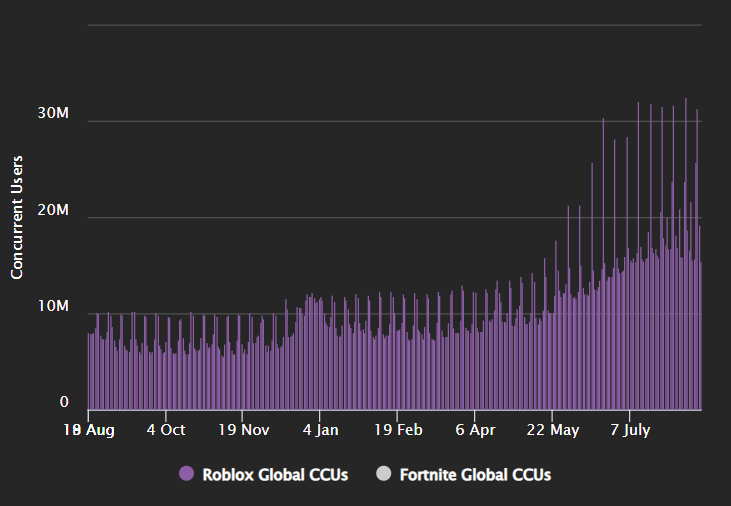
On the back of this success 2Q25 Roblox upped its fiscal year guidance, sending its share price to a new all-time high, implying a market capitalization over $95 billion. Since Hindenburg’s scathing report was published ten months ago, the share price has tripled. (The company has yet to produce a GAAP profit).
Among the sell-side analyst community, the RBLX enjoys wide support with 24 buy ratings, 8 holds just 4 sells. The average year-ahead price target stands at $141 per share.
Given that “safety issues” (a rather insincere obfuscation) are well known, the market simply assumes that whatever risk it brings must already be priced in. If it didn’t matter then, why should it now?
While scandalous allegations have been made for years, Roblox has yet to experience the true scandal. That is, despite the numerous reports of ongoing child endangerment, there has yet to be a true public or legal firestorm — a widespread and viral acknowledgment of the platform’s problems and patterns of neglect. That storm has arrived.
Over the past several weeks, a flurry of lawsuits have been filed against the company from across the country, describing horrifying stories of child abuse and laying the groundwork for a federal class action suit. Last Wednesday, a US Representative Ro Khanna (CA.D) demanded answers from Roblox. Last Thursday. Louisiana’s Attorney General filed a civil suit against the company calling it a “perfect place for pedophiles”. Last Friday, Chris Hansen of To Catch a Predator has confirmed he will soon be releasing a documentary about abuse on Roblox.
But the intense viral backlash — maybe the most significant factor in Roblox’s woes — is about a guy named “Schlep”. Over the past week, under intense public outrage and growing market scrutiny, Roblox has made a series of public relation missteps that only continue to compound.
Schlep and the Streisand Effect
Schlep is the digital persona of a 22 year-old young man named Michael from Texas. Schlep was an avid Roblox player growing up before being groomed on the platform by a well known developer beginning at the age of 13. At 15, Schlep was hospitalized after attempting to take his own life because of the experience. Despite his mother’s outreach to the company, Roblox refused to act and the abuser remained on the platform before eventually being banned years later.
Motivated by his own experience and the alleged refusal of Roblox to respond to detailed reports of abuse, Schlep began to fight the problem of pedophilia on the platform by himself, staging “sting operations”. Over the past year, Schlep’s investigations, in partnership with other internet “predator catchers” and law enforcement, has led to the arrest of six individuals. Each instance, including the Roblox interactions that laid the groundwork, are documented on his YouTube channel.
These videos were surely drawing some negative attention to the company, and one could understand why Roblox would want to stop this “sting” activity regardless of their actual moderation deficiencies. But the situation escalated dramatically on August 8th when Roblox terminated Schlep’s accounts and sent a cease and desist letter, threatening legal action if he continued.
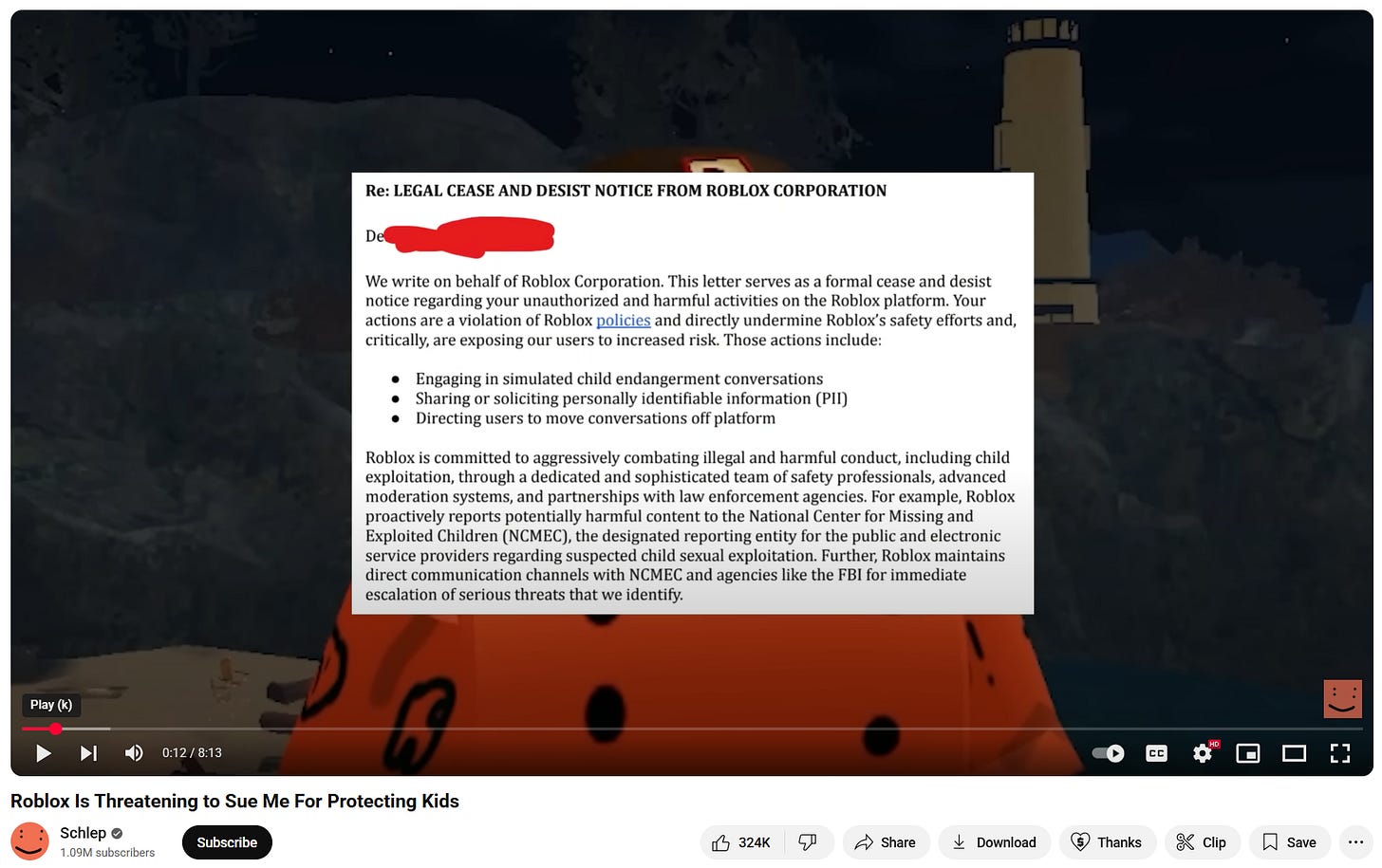
But rather than squashing this pesky PR problem, Schlep and Roblox went viral — a textbook example of the Streisand Effect. By banning this “vigilante” Roblox only solidified the narrative; Schlep is a hero, Roblox is a villain.
Here is a quick timeline of Roblox’ rocky week:
August 8 - 12th:
Schlep announces his termination from Roblox and cease and desist letter
Hashtags like #FREESCHLEP began trending on X, and large public accounts across the social media landscape began to amplify this story to a wide audience, including those previously unaware of the issues with Roblox. "Virtual protests” pop up on Roblox (ironically, they are quickly banned)
Social media momentum continues to grow by the day
Indonesia mulls banning Roblox pending transparency in moderation
Wednesday August 13th:
In response to growing criticism, Roblox publishes a blog post “More on our Removal of Vigilantes From Roblox”, effectively doubling down on their position that its content moderation is effective while comparing the vigilante activity to the predatory behavior it targets
US House Representative Ro Khanna (CA. D) creates a petition asking for transparency from Roblox regarding their child safety issues
Qatar bans Roblox over safety concerns
Thursday August 14th:
Louisiana AG announces it is suing Roblox, while calling the platform a “perfect place for pedophiles”
The largest Roblox streamer on YouTube, KreekCraft, quits the Roblox Star Program, along with several other major influencers
TD Cowen research note warns of legal risk, and reiterate sell rating $54 price target (after market hours)
Friday August 15th (market hours):
Oppenheimer research notes “safety risk” but reiterates buy rating with $158 price target pre-market
Roblox responds to Louisiana suit denying claims
Citi says it’s “not concerned” about the Louisiana lawsuit because it is “only one state” and doesn’t see engagement declining. Maintains buy rating at $152 price target
RBLX opens down ~9%, and ends the day down 6.4%
Post-Friday Close:
Chris Hansen confirms he is “deep” in the development of Roblox documentary and has already interviewed law enforcement and victims
Roblox releases two updates, “Clarifying Our Policy on Romantic and Sexual Content”, and “Update On Our Safety Initiatives (video)” promising further incremental changes
Petition to remove CEO David Baszucki reaches 100,000 signatures
Negative Roblox and awareness of the “Schlep” situation continues to escalate across social media, mainstream media, and YouTube
In each of its responses, Roblox has essentially denied there is any problem at all while begrudgingly announcing incremental safety improvements. It has been met with jeers. On X, posts from the Roblox account or David Baszucki are immediately labeled with damning “community notes” and the comments are flooded with negative responses. On YouTube, videos condemning the company’s general failure in moderation and specific response in this case are amassing millions of views.
Even Roblox’s new changes to its moderation policy opened up some uncomfortable questions. For example, in Clarifying Our Policy on Romantic and Sexual Content, Roblox states:
“We’re clarifying our policy that prohibits romantic and sexual content to also explicitly prohibit content, settings, or behavior that implies sexual activity.”
So prior to Friday, Roblox did not police “implied” sexual activity, which of course ran rampant on our site? It’s been a free-for-all so long as you maintain a modicum of plausible deniability or a strategic misspelling.
Or…
We’ve seen that Social Hangouts… can sometimes contain inappropriate user behavior when they include certain settings. We’re updating our policy to restrict social hangout experiences depicting private spaces (such as bedrooms and bathrooms) to users who are ID-verified and 17 or older. Additionally, experiences that primarily take place in these private spaces, and in settings intended for adults (such as bars and clubs), will also be restricted to only ID-verified users 17 or older.
Not only do they acknowledge that “private” bedrooms and bathrooms are being used to simulate sexual interaction between users, but up until now these games have been available to all ages. Even under this new policy, a 17-year old — still a minor — would be able to access these private bathrooms, bedrooms, bars and clubs. (After being presented with this point, Roblox has since clarified they are “considering” changing the cutoff to 18).
Finally, Roblox points to its National Center for Missing & Exploited Children (NCMEC) reports (which are required by law) as both evidence of its moderation, and the relatively low frequency of reports as proof of the platform’s safety. But clearly the numbers should be read in the opposite direction. Despite running the most popular platform for young children, the company produces only a tiny fraction of NCNEM reports submitted by social networks, even after adjusting for user base, suggesting incredibly weak reporting standards.
In all fairness, some problematic games have been removed — like this one titled “XYZ Public Bathroom Simulator Hangout” which was active on Roblox site since 2024 and visited over 7 million times.
Yet, as of Sunday evening, the first result in a query for “Public Bathroom Simulator” on Roblox’s discover page revealed plenty of new options, like this one below — created on Saturday afternoon (after Roblox’s alleged rule-change) which has already been visited 13,700 times, with 243 active users and no age restrictions. The purpose of this game, apparently, is to “use the toilet, wash your hands, and strike up some conversation!”
While these bathroom examples stand out as strikingly lewd, there are plethora of highly suggestive, completely unrestricted, games that are equally or even more disturbing; titles like “Boys and Girls Immersive Party Roleplay” — currently hosting 695 active players of all ages.
And as the internet firestorm continues to rage, some sleuths are digging up new dirt.
For example, Chief Safety Officer Matt Kaufman has previously identified his personal Roblox account as “RbxRocketMan” at official Roblox events in the past. RbxRocketMan’s user profile — still publicly accessible as of writing — shows “badges” earned from at least six different highly suggestive games (like “condo games” which are rooms used for sexual simulation) many of which have since been banned after backlash. Screenshots from these “games” are below.
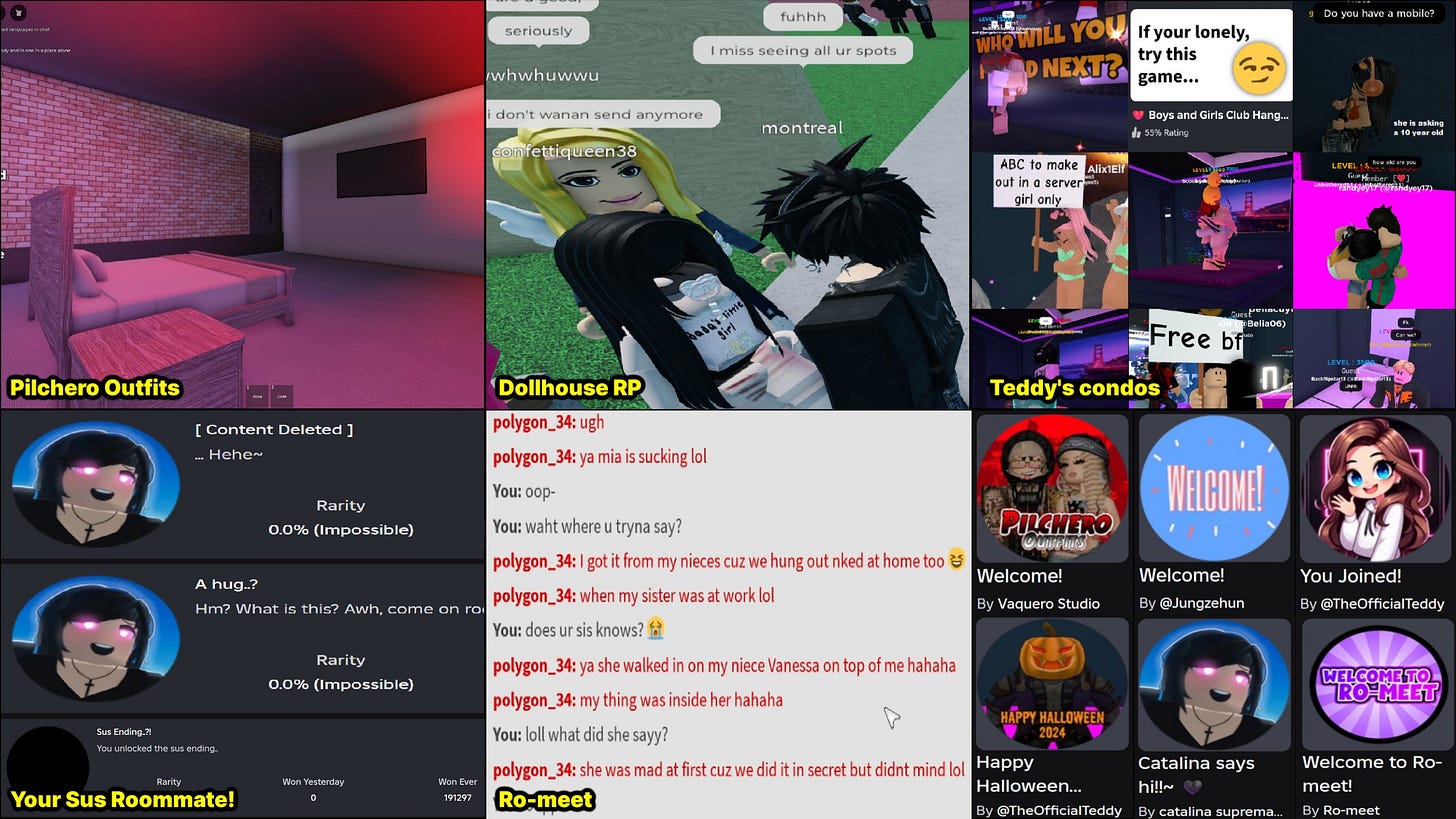
The first "favorited” game on RbxRocketMan’s profile is “Meep City” a game notorious for its private “party room” features and frequent sexual content, that was eventually pulled from the platform in response to years of backlash. The game has since been reinstated, with private rooms disabled.
Assuming this is indeed Kaufman’s account, the best possible explanation is that he was exploring these games for moderation purposes (though moderating through a personal account seems like an unusual method). And even if the purpose was moderation — these rooms remained online long after RbxRocketMan’s visits, meaning that his explorations found them to be suitable for children. Only after the intense public backlash (and market cap losses) did Roblox begin to remove some of this content.
While maybe not outright damning, these breads crumbs mirror prior concerns about Roblox staff, like those outlined in Problems at Roblox which showed that the former Head of Moderation and key social media managers were engaging with or producing explicit sexual content with childish themes on their personal social media accounts. When combined with high-profile Roblox developers being convicted for grooming and abuse, and the mind-numbing refusal of the platform to introduce basic safety features (except under extreme market pressure), it becomes harder to assume that this deviant behavior is merely an external force of bad actors.
Legal Firestorm
This crescendo of public attention has been mirrored by crescendo of legal action. So far, I have identified thirteen separate civil lawsuits in 2025 alone naming Roblox as a defendant, spanning seven state courts and three federal US district courts. This list is probably not exhaustive. All of the cases outline strikingly similar patterns: including grooming, exploitation, abduction, and rape, with victims as young as eight. All of the interactions began on the Roblox platform.
Nine of these cases have been filed since July alone, with the pace rapidly increasing over the past two months. Most suits are being filed by a handful of mass-tort and class-action litigators (Anapol Weiss, Milberg, Dohman Law) with strikingly similar legal arguments and fact patterns across many state and federal jurisdictions.
This is just the tip of the iceberg. Milberg — a self-described pioneer of class-action lawsuits — indicates it already represents 400 victims of sexual exploitation on Roblox. In short, the “seeding” of a class-action lawsuit is well underway, with this flurry of independent lawsuits across the country meant to demonstrate a nationwide concern.
Beyond these direct suits from citizens, Roblox received a subpoena from the Attorney General of Florida concerning child endangerment in April 2025, long before the Louisiana AG’s lawsuit was announced last week.
Roblox has dodged or settled lawsuits in the past — including ones related to child endangerment — but it has never received an onslaught like what we are seeing today, including the involvement of state AGs (and maybe eventually the feds). Despite many of these lawsuits (and the Florida subpoena) occurring before Roblox released its 2Q25 10Q on July 30th, the company makes no mention of the cases in their legal contingencies or subsequent events, meaning the company continues to view them as “immaterial”.
While online platforms enjoy broad protection under Section 230, Roblox is far from bulletproof. Section 230 would not shield the company from design negligence claims, fraudulent misrepresentation in public statements, or sex-trafficking. Even in its own risk disclosures, Roblox acknowledges that it could be found criminally liable for child pornography or sexual exploitation of a child domestically and abroad. Per its 10K filing:
“non-compliance by us or allegations of non-compliance by us with respect to U.S. federal laws on child pornography or the sexual exploitation of children could significantly harm our reputation, create criminal liability, and could be costly and time consuming to address or defend. We may also be subject to additional criminal liability related to child pornography or child sexual exploitation under other domestic and international laws and regulations.”
Notably, I emphasize the role of Robux — the game’s virtual currency. Robux can be transferred between players for a 30% fee through in-game purchases and cashed-out by developers for 65% fee (the fees are taken by Roblox as profit). Many predator cases describe Robux payments being used to coerce children into providing sexual content, or simply being used to facilitate financial transfers between adult predators (even if the actual content is exchanged off the platform). In these exchanges Roblox is both laundering and directly profiting from the financial exchange of criminal material. (This currency connection is already the subject of illegal gambling accusations — a separate legal can of worms we will ignore for this piece).
Roblox faces numerous legal vulnerabilities, ranging from civil penalties, to mandated reforms, and even potentially criminal liability. Even if a settlement is the most likely outcome — largely to avoid discovery — this issue is not going away. And the more Roblox is forced to speak about it honestly, the worse it becomes.
Priced In
The bull case for Roblox is simple. The company is putting up great numbers with growing users and viral hits. “Safety” allegations have been made before and the “shorts” have gotten smoked. This too shall pass.
At 20x sales after a nearly 100% YTD run, the market has certainly believed the bull case. Only on Friday, after the Louisiana AG suit, did we see the first real admissions of investor concerns.
We don’t know if Roblox will be held accountable for its blatant moderation failures. We don’t know when it that will occur, and what the consequences would look like — undoubtedly there will be a massive legal battle on the way. I also recognize that there are many players who genuinely love the platform and have not been exposed to harmful content. But a serious reckoning and reform is long overdue — and might just be arriving.
At what point does an investor admit that a children’s platform crawling with pedophiles is a material risk? At what point does an analyst admit that endorsing such a platform is a career risk? At what point do you stop believing that “the predators are priced in”?


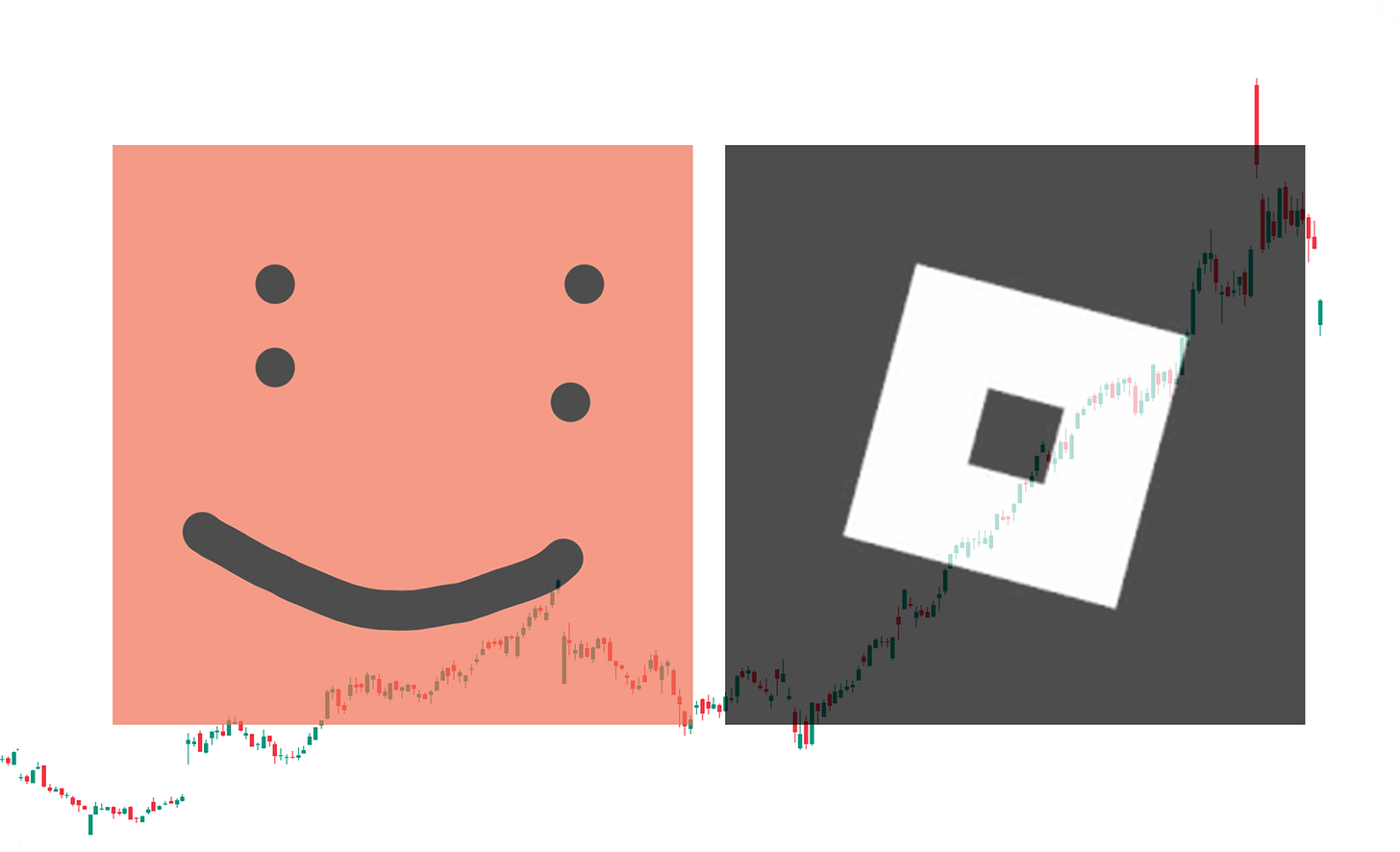


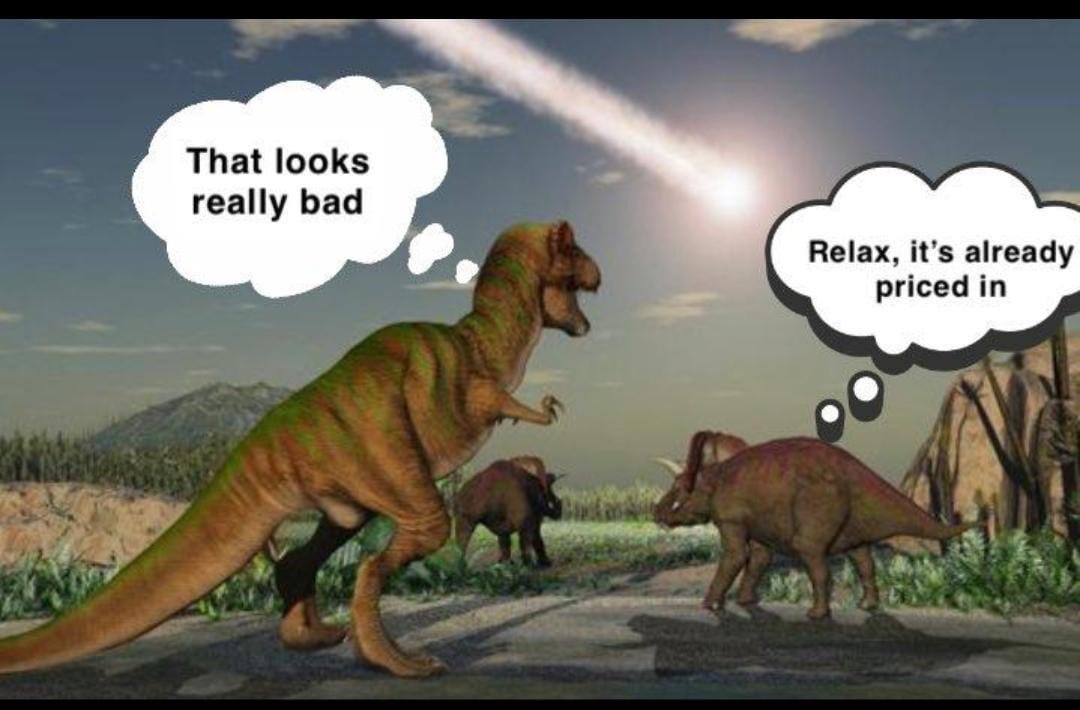

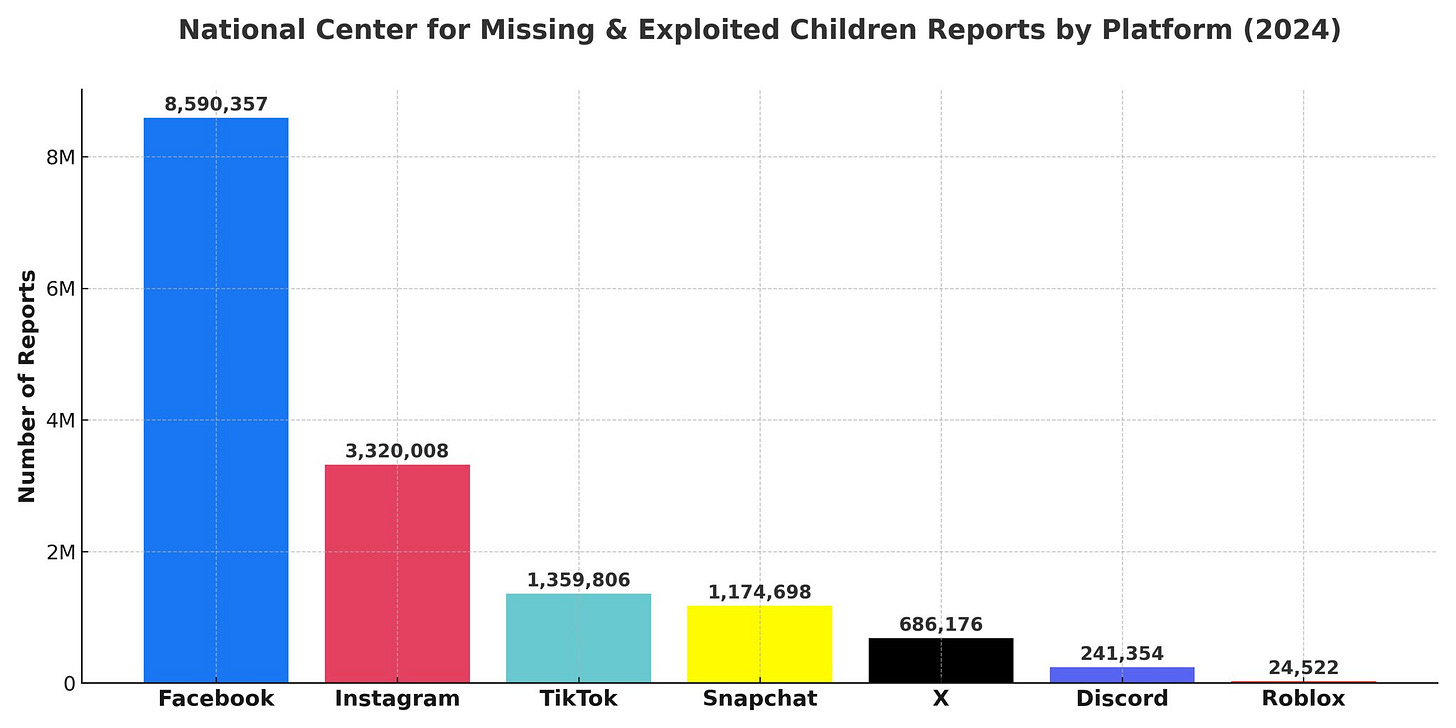
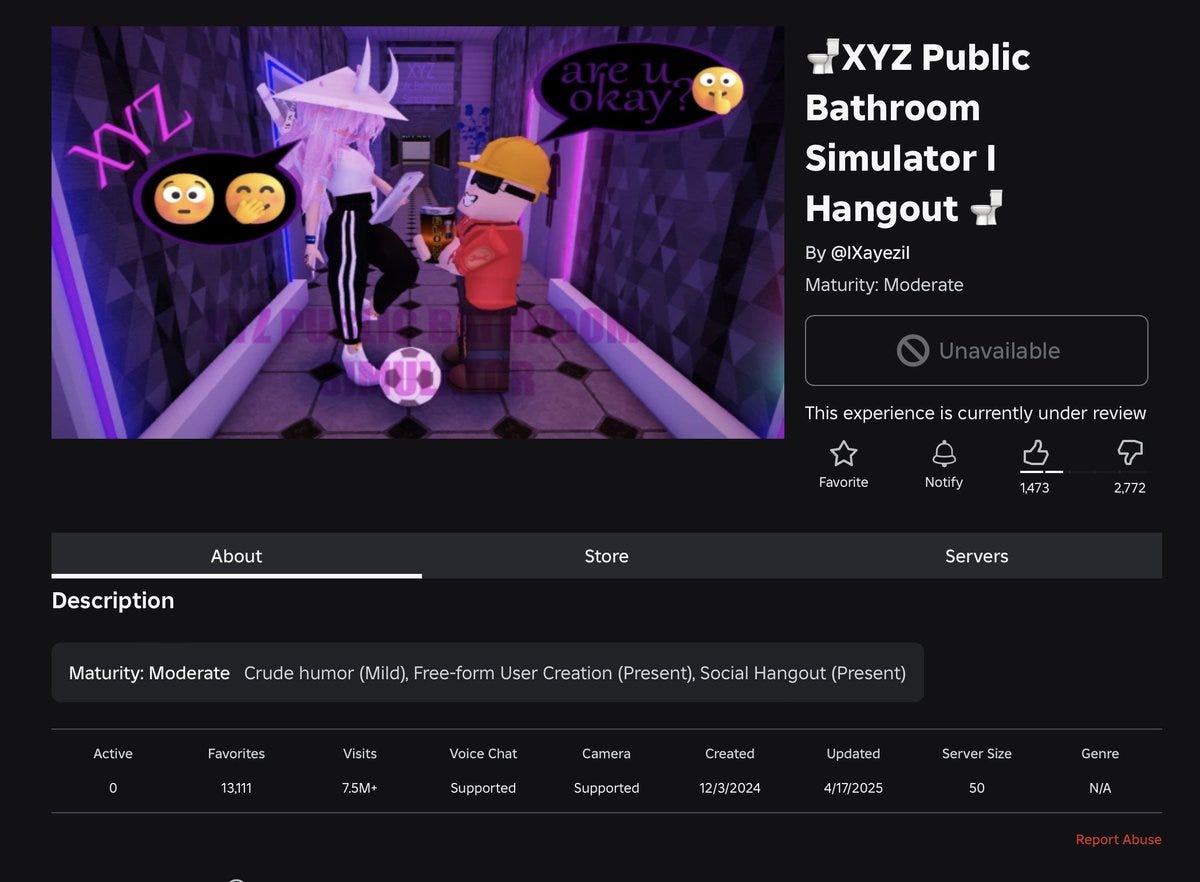
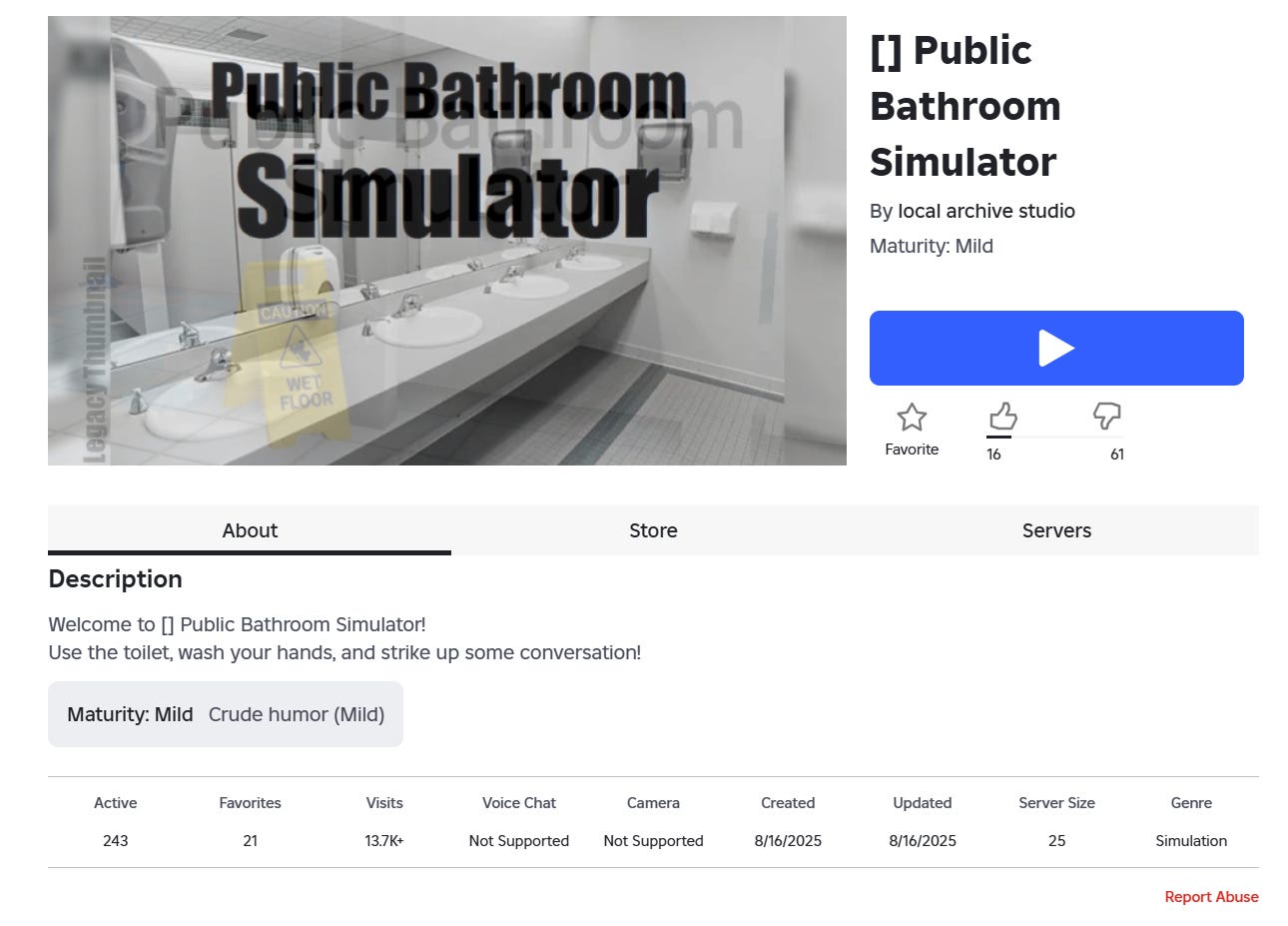

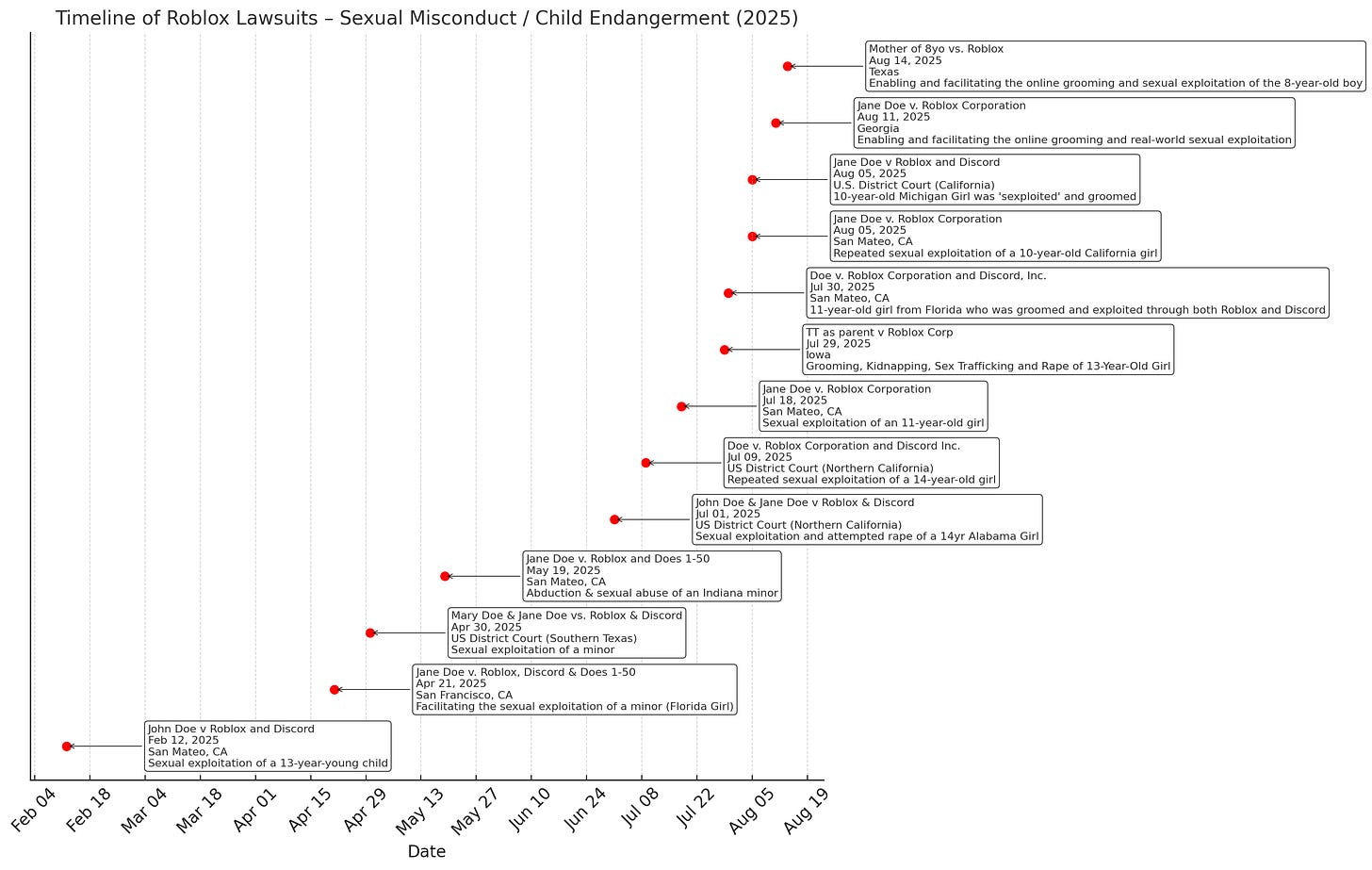

Nice to hear from you Bear! Great piece and well timed. IMHO, shorting single name stocks is the hardest game in town and "Shoot them in the back" is about the only way to trade them. Cheers.
Thank you Mr. Bear! Glad to read you again!